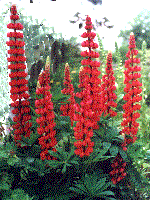 |
LEGUMINOSAE (now separated into CAESALPINIACEAE, FABACEAE, MIMOSACAE, PAPILIONACEAE) - The Pea Family
This is one of the largest and most useful plant families. - 17,000 species, distributed almost throughout the world. It includes many well-known vegetables particularly of temperate regions (Beans, Peas), ornamental trees in tropical regions (Bauhinia, Flamboyant, Cassia), fodder crops (Clover, Lucerne) and weeds (Vetches and Trefoils), and their growth habits vary from ground cover and aquatic to shrubs, climbers and trees. Many species of trees in this family are important for their timber. (I'm sorry, but the differences between the new families are too complicated for me, so I'm lumping them all together under the old name Leguminosae) |
CHARACTERISTICS OF THIS PLANT FAMILY:
Leaves, Stem & Roots ~ The leaves of this plant family are placed alternately up the stem, and are pinnate or bipinnate. In some species, the leaves are able to close together at night (nyctinasty), and in some species of Mimosa they close when touched. The roots are one of the most easily recognisable features of this plant family. Most species have irregular nodules on the roots which enable the plant to absorb nitrogen from the air in the soil and convert it into the nitrogen the plant needs for growth. This enables the species to grow and produce crops in poor soil.
Flowers ~ Many members of the Leguminosae family have flowers of the typical 'pea' type. These are composed of one large back petal (the standard), two side petals called wings and two lower petals fused together to form a 'keel'. In members of the family which have other flower shapes, there are still five petals. The flowers may occur individually, or in large clusters.
Recently, the international panel of botanists who rule on these things decided that all plant families ought to have the same ending (-aceae), and be named after a plant typical of the family. This has resulted in several groups which were previously sub-families of the Leguminosae being elevated to family status. These new plant families include Caesalpiniaceae, Fabaceae and Papilionaceae. The differences which separate the members of these new families may be unidentifiable to the non-botanist, and the similarities which they share as members of the Leguminosae family are still the easiest way to identify these plants.
Seeds ~ It is the seedpods that give this family its original name. The typical pea-pod shape is a legume. It is always a single chamber, although it may be constricted between the individual seeds. The pod may contain just one or several seeds, and they are usually large, and sometimes brightly coloured. The coat of the individual seed is often watertight. Each seed contains a large embryo and little endosperm, so they often germinate quickly once the seedcoat is punctured.
(Click here for more information and examples of seedpods in this Family.)
Members of this Family usually have:
Pea flowers
Nodules on the roots
Pinnate leaves
Seeds in pods like peas or beans